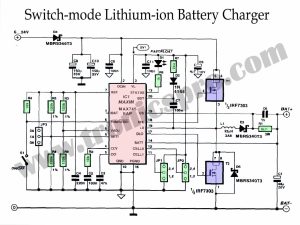Introduction
There are many applications where a 230 V a.c. at 50 Hz is needed to operate an appliance in the absence of mains supply. Devices to supply this kind of power are known as inverters. They draw electrical energy from a battery (a rechargeable battery in most cases), chop the d.c. and then step up the a.c. voltage by a step-up transformer. The chopping frequency in most cases, is about 50 Hz. Frequency accuracy and stability is not important so long the device is not used to power a frequency sensitive appliance such as a synchronous motor of a clock. In this article, we will discuss about a simple inverter circuit diagram with symmetrical multivibrator using a pair of 2n3055 transistors.
Medium size inverters are used to operate things such as emergency lights, TV receivers and computers. High capacity units are used to power lights and fans in a house during failure of the mains supply. These inverters are designed to start up automatically and immediately as soon as the failure of mains supply occurs, and switch off themselves when the mains supply is restored. When the mains supply is available, a built-in charger circuit keeps the battery in its fully charged state.
Simple Inverter Circuit Diagram
This project can be designed using a few basic components. The circuit diagram of this project is shown below.
More Circuit Layouts








Components List of Simple Inverter Circuit Diagram
Following is the list of all components used in this project:
- 2N3055 Transistor = 2
- SL100 Transistor = 2
- 4.7uf Capacitor = 1
- 0.47uf Capacitor = 1
- 15k Resister = 2
- 220 Ohms Resister = 2
- 6-0-6V x 230V Transformer = 1
Working Explanation of Simple Inverter Circuit Diagram
Previously the inverters uses a mechanical vibrator. Today, most inverters use a 50 Hz square wave generator ( e.g., a multivibrator), which drives switching transistors. One example of this kind of inverter is shown in the above given circuit diagram.
Transistors T1 and T2 form a free-running multivibrator. Their outputs are given as base drives to transistors T3 and T4. The collector currents of these transistors feed the two halves of the center-tapped primary winding of the power transformer.
More projects, You may like:
- Video Transmitter DIY Homemade FM Radio Transmitter
- Adjustable Power Supply DIY Battery Charger
- 12V-220V 500 Watt inverter DIY Homemade
- 12V-220V H-Bridge Inverter DIY Homemade
- MPPT Solar Charge Controller DIY Homemade
- 18650 battery bank free charge protection module
- D718 B688 Bass Amplifier Homemade DIY
- C5200 Bass Amplifier DIY Homemade with Volume
- DIY LA4440 bass amplifier homemade
- C5200 A1943 TDA2030 Amplifier DIY Homemade
For more project and circuit diagrams, you can go through the Schematics in the main menu where you can find many interesting projects and circuit diagrams like audio amplifier circuits, voltage booster circuit, battery charger circuit and timer circuits etc., which are all beginner circuit projects. Feel free to check them out!

Thank you for visiting the article.


























